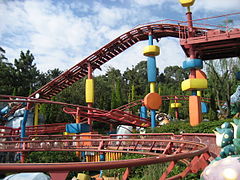Tokyo Disneyland
Tokyo Disneyland (東京ディズニーランド, Tōkyō Dizunīrando) (local nickname TDL)[1] is a 115-acre (47 ha) theme park at the Tokyo Disney Resort in Urayasu, Chiba Prefecture, Japan, near Tokyo.[2] Its main gate is directly adjacent to both Maihama Station and Tokyo Disneyland Station. It was the first Disney park to be built outside the United States and it opened on April 15, 1983. The park was constructed by WED Enterprises in the same style as Disneyland in California and Magic Kingdom in Florida.[2] It is owned by The Oriental Land Company, which licenses intellectual property from The Walt Disney Company. Tokyo Disneyland and its companion park, Tokyo DisneySea, are the only Disney parks in the world not owned or operated by The Walt Disney Company in any capacity.
Location
Tokyo Disney Resort, Urayasu, Chiba Prefecture, Japan
Operating
April 15, 1983
The Kingdom of Dreams and Magic
115 acres (47 ha)
The park has seven themed areas: the World Bazaar, Adventureland, Westernland, Fantasyland, Tomorrowland, Critter Country and Toontown. Many of these areas mirror those in the original Disneyland as they are based on American Disney films and fantasies. Fantasyland includes Peter Pan's Flight, Snow White's Scary Adventures, and Dumbo the Flying Elephant, based on Disney films and characters.[3] The park is noted for its extensive open spaces to accommodate the large crowds that visit the park.[2] In 2022, Tokyo Disneyland hosted 12 million visitors, making it the fourth-most visited theme park in the world and the second-most visited theme park in Asia.[4]
History[edit]
The idea of a Japanese Disneyland dates back to the late 1950s when Japanese businessman Kunizo Matsuo approached Walt Disney with the idea of a Disney park in Nara. While it is rumored Walt initially agreed to the idea, he later dropped out of it. Matsuo, still determined to open his Disney-themed park, opened Nara Dreamland in 1961, a near replica of Disneyland except without Disney characters or intellectual property. This park would continue to operate until 2006.
Masatomo Takahashi of The Oriental Land Company approached Walt Disney Productions with the idea of Tokyo Disneyland in August 1978. Due to the success of the recently opened Disney World in Florida, Disney and Takahashi negotiated, and the initial contract for the construction of Disneyland in Chiba Prefecture was signed in April 1979.[5] Japanese engineers and architects visited California to tour Disneyland and prepare to construct the new park.[6] The construction of the park began a year later and was covered by hundreds of reporters as an indication of the high expectations for the park in the future. The final cost of Tokyo Disneyland was 180 billion yen rather than the projected 100 billion yen.[6]
On February 28, 2020, Oriental Land announced a temporary closure of Tokyo Disneyland and DisneySea from February 29 to combat the COVID-19 pandemic.[7] The closure, originally slated to expire in mid-March, was later extended twice, with the latest extension being until July 1, 2020.[8]
Future[edit]
Since the park opened in 1983, Tokyo Disney Resort has regularly been one of the most profitable Disney resorts. By 1994, over 149 million people had entered through the gates of Tokyo Disneyland, more than Japan's entire population of 127.6 million at the time.[29] In 1996, it employed 12,390 people, making Tokyo Disneyland the biggest workplace in Japan's diversionary outings at that time.[29] Many speculate that Tokyo Disneyland is such an economic success due to timing and location; the theme park lies in a metropolitan area with a population of 30 million and opened at the height of a booming economy where hard-working citizens desired an escape from reality.[30]
Tokyo Disneyland states that one of its main aims is to improve the park and diversify from the limits of the domestic Disney parks. Tokyo Disneyland has recently been adding a national identity within the parks by adding attractions with distinctly Japanese qualities. Cinderella Castle displays the Disney character and story plot yet presents the story through the eyes of the Japanese. Once dominated by Disney Legends, Masatomo Takahashi, the former president of The Oriental Land Company, states this growth and development as one of its primary goals: "We must not just repeat what we receive from Disney. I am convinced that we must contribute to the cultural exchange between Japan and U.S.A."[6]






